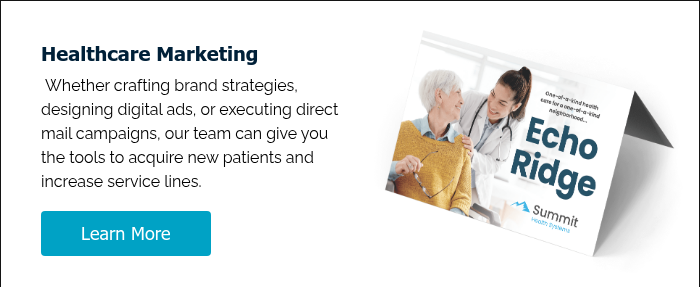How Marketing Guides Patients Before Booking Healthcare Appointments
Streamworks Blog
.jpg?width=1000&height=500&name=HugBlogPhoto%20(1).jpg)
This article will discuss healthcare marketing strategies, providing readers with an informative guide to creating impactful campaigns, exploring key approaches, and examining the implications for both patients and providers.
Many people take a multi-step journey before scheduling an appointment with a healthcare provider, making decisions long before they walk through the door. The importance of understanding the patient journey and marketing's role in guiding decisions cannot be overstated. By recognizing and supporting each phase in this journey, and tailoring marketing approaches to different audiences, healthcare clinics and hospitals can build stronger relationships and ultimately help consumers make better-informed choices about their care. Here’s how marketing at each stage can make a difference, incorporating digital strategies, direct mail, and more.
Creating effective marketing content and strategies is essential for engaging audiences and establishing credibility. The healthcare marketer plays a crucial role in guiding these efforts, ensuring that messaging resonates with diverse groups and supports organizational goals. The implications of effective healthcare marketing strategies extend beyond patient engagement, influencing patient choices and shaping the future of healthcare delivery.
Introduction to Healthcare and the Patient Journey
The healthcare industry is a dynamic and ever-evolving field, where understanding the patient journey is essential for success. Healthcare providers and organizations face the ongoing challenge of raising awareness about their health services while developing marketing strategies that truly resonate with patients. At the heart of effective healthcare marketing is the ability to create a clear path for patients—guiding them from initial awareness to informed decision-making and, ultimately, to accessing the care they need.
Healthcare companies must focus on building trust with their audience by providing valuable education and resources that empower patients to take charge of their health. In today’s digital landscape, leveraging digital marketing platforms is crucial for reaching patients where they are and promoting services in a way that encourages patient engagement. By prioritizing awareness and education, healthcare organizations can not only improve health outcomes but also establish themselves as leaders in the healthcare field, ensuring that patients feel supported and informed at every step of their journey.
Stage 1: The DIY Approach – Supporting At-Home Remedies and Self-Care with Educational Content
In the DIY phase, consumers often start by trying to resolve health issues independently, relying on home remedies or basic self-care. Marketing can meet them here by providing credible, easy-to-understand information about at-home care options and when it’s best to seek professional help. Tailoring content to fit the patient's lifestyle and daily habits can make health advice more relevant and actionable. Additionally, marketing plays a crucial role in bridging the gap between complex medical information and what patients understand at home, ensuring that guidance is accessible and practical.
Digital Marketing: Use blog posts, videos, and social media to share tips on common health concerns, such as home remedies for colds, minor injuries, or stress management. SEO-optimized content is essential to ensure your information appears in search results when consumers seek health advice. Digital content informs customers by providing reliable health information that helps them make better decisions. Visual content, such as infographics or short YouTube videos, can also be powerful in simplifying complex information and keeping viewers engaged.
Direct Mail: Direct mail campaigns can be effective, too, especially when promoting seasonal health tips. For example, a flyer on flu prevention with details about flu shot clinics can encourage customers and patients to care for their health proactively.
By establishing your healthcare organization as a trusted source of preventive advice, you can build brand recognition and ensure that patients think of you when the need for care arises. Maintaining credibility and trust in your educational content is essential for long-term engagement and reputation.
Stage 2: The On-Demand Research Phase – Providing Accurate, Accessible Online Resources
At this stage, consumers are actively researching their symptoms and treatment options online. The internet serves as a primary source for health information during this phase, with many individuals turning to digital platforms to find answers. They may be exploring various symptoms, potential diagnoses, and treatment options. Marketing that guides them toward accurate, professional resources helps them gain the insights they need while building trust with your organization.
Digital Marketing: Optimize your website for search engines so that it appears in symptom-related searches. Create detailed service pages that describe specific conditions and treatment options available at your clinic or hospital. Consider adding online tools like symptom checkers or “when to seek care” quizzes to engage visitors and encourage them to take the next step. Leverage technology and digital tools to enhance the research experience, making it easier for potential clients—those who are researching but have not yet chosen a provider—to find and interact with your content. Paid search ads can also help you reach potential patients when they’re seeking answers. Emphasize the value of providing detailed, accurate information, as this helps differentiate your organization and builds trust. Medical organizations can further establish themselves as trusted sources of online health information by offering comprehensive and reliable resources.
Social Media: Use social media platforms like Facebook, Instagram, and LinkedIn to share educational content and patient stories. These posts can link to your website for more information, directing consumers toward credible answers when searching for solutions.
Direct Mail: This stage can also benefit from direct mail when you know your audience. For example, you might send targeted mailers on specialty services such as orthopedics or heart health to households in your area. Include information about health insurance coverage, such as plan benefits or how to compare deductibles and co-pays, to help recipients better understand their options. Highlight the expertise of your team and direct recipients to a website or phone number to learn more, integrating traditional mail with digital for added impact.
Leveraging Expertise and Thought Leaders to Build Credibility
Credibility is a cornerstone of success in the healthcare industry. For healthcare organizations, demonstrating expertise and thought leadership is key to building trust with patients and establishing a strong brand presence. One effective marketing strategy is to create informative articles, blog posts, and educational resources that address common health concerns and highlight the organization’s commitment to high-quality care.
Healthcare providers can further enhance their reputation by hosting webinars, community events, and partnering with respected thought leaders or doctors in the field. For example, collaborating with a renowned doctor to develop a campaign focused on chronic conditions can help raise awareness about prevention and treatment, while also showcasing the depth of knowledge within the organization. By leveraging the expertise of healthcare professionals, organizations can inform their marketing strategies, ensuring that campaigns are both accurate and impactful. This approach not only builds trust with patients but also differentiates the healthcare organization from competitors, positioning it as a trusted authority in the healthcare industry.
Stage 3: The Consultation – Building Trust and Community with Success Stories and Referrals
Consumers now ask trusted friends, family, or online communities for advice. This stage emphasizes word-of-mouth referrals, so building a solid reputation and fostering positive patient relationships is critical.
Digital Marketing: Testimonials and success stories on your website, Google Business profile, or social media can demonstrate patients’ quality of care at your facility and help build strong brands and brand identity. Encourage satisfied patients to leave reviews online, as these carry significant weight in today’s decision-making process. Email marketing is another way to connect with past patients. You can send newsletters that share health tips and clinic updates to keep your organization top-of-mind.
Community Engagement and Events: Hosting health seminars or webinars, sponsoring local events, or offering free screenings can position your organization as a trusted community resource. Launching an initiative, such as a health awareness campaign, can further demonstrate your commitment to public health. These activities foster a sense of community and belonging among local residents. Encourage participants to bring a friend or family member, increasing your visibility and opportunities for direct referrals.
Direct Mail: Personalized follow-up mailers or newsletters to past patients are a great way to foster ongoing relationships. These mailers can include highlights of new services, upcoming events, or seasonal reminders, reinforcing a connection and reminding patients that you’re there when they or someone they know needs care.
Ongoing engagement and referrals offer significant benefits for both patients and your organization, such as improved health outcomes, stronger relationships, and increased loyalty.
Unique Challenges in Healthcare Marketing
Marketing in the healthcare industry presents unique challenges that set it apart from other industries. Healthcare marketing must navigate a landscape shaped by strict regulations, ensuring that all advertising and promotional efforts comply with legal and ethical standards. Additionally, the personal and often sensitive nature of health services requires marketers to approach their audience with empathy and care, avoiding tactics that could be perceived as exploitative or insensitive.
Healthcare marketers must also address the diverse needs and concerns of multiple stakeholders, including patients, providers, payers, and regulators. To overcome these challenges, successful marketing strategies often incorporate interactive tools and digital platforms that educate and engage patients, making complex health information more accessible. By leveraging the expertise of healthcare professionals and staying informed about industry trends, marketers can develop campaigns that resonate with their audience, build trust, and effectively promote health services. Ultimately, understanding and addressing these unique challenges is essential for any healthcare organization aiming to make a meaningful impact through its marketing efforts.
Measuring Campaign Success in Patient Acquisition
For healthcare organizations, measuring the success of marketing campaigns is essential to ensure that efforts are driving real results. One of the most important metrics is patient acquisition—the ability to attract new patients through targeted marketing strategies. Healthcare marketers can track patient acquisition by monitoring website traffic, analyzing engagement on digital platforms, and evaluating conversion rates from online and offline campaigns.
Social media sentiment, patient feedback, and retention data also provide valuable insights into the effectiveness of marketing initiatives. By leveraging data analytics, healthcare organizations can identify which channels and messages are most successful in raising awareness and building trust with potential patients. For example, a healthcare organization might discover that educational content shared on social media leads to higher patient engagement and more appointment bookings, prompting a shift in marketing strategy to focus on these channels. Continually measuring and refining marketing campaigns ensures that healthcare organizations maximize their impact, optimize their resources, and achieve lasting success in patient acquisition and engagement.
Integrating Marketing Across the Consumer Journey for a Seamless Experience
Consumers’ healthcare journeys can span days, weeks, or even months as they consider their options and weigh when to seek help. Using digital marketing and direct mail at each stage, your clinic or hospital can ensure patients receive valuable information and reassurance throughout their decision-making process. It is essential to maintain compliance with regulations such as HIPAA at every stage to build trust and ensure ethical communication. Integrated marketing should also provide clear information about medicine, treatment options, and services, while recognizing that different healthcare systems may require tailored strategies to address their unique challenges and patient populations.
Together, digital and traditional marketing can create a seamless experience that meets patients wherever they are in their journey, ultimately helping them make confident, well-informed decisions about their health. For example, promoting physical activity through year-round campaigns can encourage healthy behaviors and community engagement regardless of the season.
Final thoughts
Integrating marketing across the healthcare journey requires attention to compliance, tailored strategies for diverse healthcare systems, and providing comprehensive information about medicine and healthy behaviors like physical activity to support patient decision-making.




